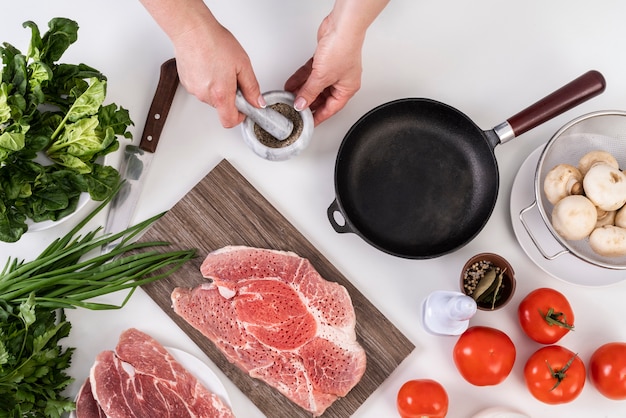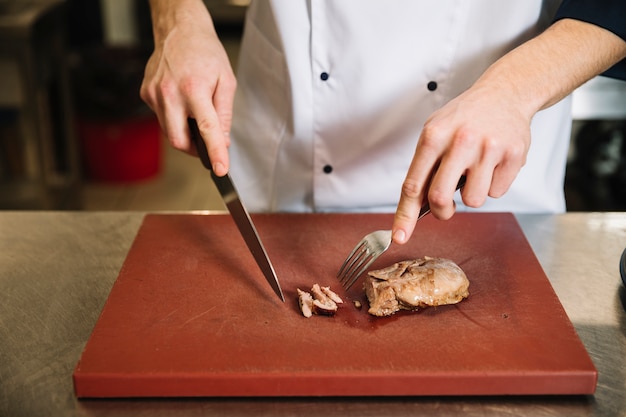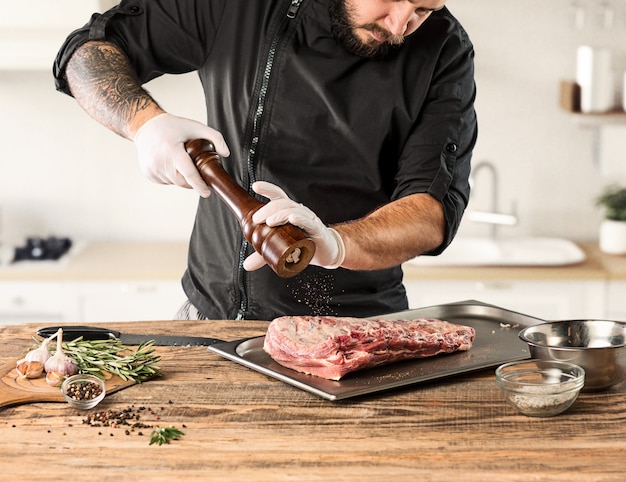Let’s face it, there’s nothing quite as satisfying as a perfectly cooked steak. It’s the kind of meal that can turn a simple weeknight dinner into a celebration. The problem is, nailing that juicy, tender, perfectly seared steak isn’t always as easy as it looks. I've been there, staring at a hunk of raw beef, feeling a bit overwhelmed, wondering if I'm about to ruin dinner. But trust me, it's not as scary as it seems. With a little knowledge and a bit of practice, you can nail a steak that'll have everyone begging for seconds.
This isn't just some generic guide, mate. This is the culmination of years of experimenting in the kitchen, from my first attempts at grilling to mastering the art of reverse searing. I've learned the hard way, made plenty of mistakes, and emerged with a wealth of tips and tricks that I'm eager to share.
We'll cover everything from choosing the right cut to mastering different cooking techniques. We'll delve into the secrets of seasoning and resting, and I'll even spill the beans on my favourite sauces and sides. So grab a pen, a bottle of your finest red, and let's get started on this culinary journey.
(Part 1) The Steak Commandments: Choosing the Right Cut

You can’t just grab any old piece of beef and expect it to turn into a culinary masterpiece. Choosing the right cut is the foundation of a great steak. Think of it like picking a team for a football match – you wouldn't choose a striker to play goalie, would you? Each cut has its own unique characteristics, and understanding those characteristics will help you choose the perfect steak for your needs.
The Holy Trinity of steak cuts
There are three cuts that stand out as the undisputed kings of the steak world. These are the cuts that you'll find on the menus of top-notch steakhouses, and for good reason. They’re consistently delicious and deliver on the promise of a truly satisfying steak experience.
- Rib-eye: This is the classic steak, known for its marbling and buttery flavour. The marbling, those streaks of fat running through the meat, is what gives the rib-eye its rich, succulent flavour. It’s the perfect choice for a special occasion or when you want to impress. If you’re looking for the ultimate steak experience, the rib-eye is your go-to.
- Sirloin: A bit leaner than rib-eye, but still packed with flavour. This makes it a versatile cut that’s great for grilling, pan-frying, or even roasting. It’s a great choice for those who prefer a leaner steak without sacrificing flavour.
- Fillet: The most tender cut, with a delicate flavour. It’s also known as tenderloin, and it’s prized for its incredible tenderness. This makes it perfect for those who prefer a melt-in-your-mouth experience. If you’re looking for a steak that’s as smooth as butter, the fillet is your best bet.
Choosing the Right Grade
Once you've chosen your cut, it's time to consider the grade of the beef. This tells you about the amount of marbling, which affects the flavour and tenderness. The higher the grade, the more marbling there is, and the richer and more tender the steak will be.
In the UK, we typically use the following grading system:
| Grade | Description |
|---|---|
| R | Standard, everyday beef, typically used for mince or stews. Not ideal for steaks. |
| U | Slightly better than R, but still not ideal for steaks. |
| R4 | A good all-around grade, suitable for grilling and roasting. |
| R3 | A step up from R4, offering more marbling and flavour. |
| R2 | prime beef, with excellent marbling and flavour. Ideal for steaks. |
| R1 | The highest grade, reserved for the most tender and flavoursome cuts. |
For a truly exceptional steak, aim for R2 or R1. You won't regret it. These grades offer the perfect balance of flavour and tenderness, making for a truly unforgettable steak experience.
(Part 2) The Art of Seasoning

Now, let's talk seasoning. It’s like adding the finishing touches to a painting – a little bit goes a long way. The right seasoning can transform a good steak into a truly exceptional one. It’s all about finding the right balance and enhancing the natural flavour of the beef.
Salt is King
Salt is your best friend. It doesn’t just add flavour, it also helps to draw out moisture from the meat, which creates a crispy crust and enhances the overall tenderness. You don’t need to go overboard, but don’t be afraid to use a generous amount. Use coarse sea salt, as it holds onto the moisture better and won't dissolve as quickly.
Pepper is the Prince
Black pepper adds a bit of spice and bite. Use freshly ground black pepper for the best flavour. It adds a touch of complexity and helps to create a satisfying mouthfeel.
Beyond the Basics
While salt and pepper are the core duo, feel free to get creative with your seasoning. Herbs like rosemary, thyme, and oregano add a lovely aroma and flavour. Garlic powder and onion powder can also add depth and complexity. And if you’re feeling adventurous, try a pinch of smoked paprika or cayenne pepper for a kick. The key is to experiment and find what you like best.
My tip: Season your steak at least 30 minutes before cooking. This allows the salt to penetrate the meat and break down the proteins, resulting in a more tender and flavourful steak. You’ll be amazed at the difference this simple step makes.
(Part 3) Mastering the Grill

Right, let's get grilling! This is where the real magic happens. The grill is the classic way to cook steak, and it’s a technique that can be mastered with a little practice.
Prepping the Grill
Start by preheating your grill to high heat. This ensures a beautiful sear and a perfectly cooked steak. A hot grill is essential for achieving that crispy crust and locking in the juices.
Grilling Technique
Once the grill is hot, place your steak directly over the flames. Don't be afraid to let it sizzle! Cook for 2-3 minutes per side for a rare steak, 4-5 minutes for medium-rare, and 6-7 minutes for medium. The timing will depend on the thickness of the steak, but these are good starting points.
Flip the steak only once. Resist the urge to keep checking on it – every flip disrupts the cooking process and can make the steak unevenly cooked. Let it cook undisturbed for a few minutes on each side to allow for a nice even sear.
The perfect sear
The goal is to achieve a beautiful, crispy sear on both sides. This not only looks impressive, but it also locks in the juices and flavour. A good sear is a sign that your steak has been cooked properly and will be tender and juicy on the inside.
Using a Grill Thermometer
Once the steak is seared on both sides, it’s time to move it to indirect heat. This is where a grill thermometer comes in handy. Insert the thermometer into the thickest part of the steak and cook until it reaches your desired temperature.
Here's a guide to the internal temperatures of a steak:
- Rare: 125-130°F (52-54°C)
- Medium-rare: 130-135°F (54-57°C)
- Medium: 135-140°F (57-60°C)
- Medium-well: 140-145°F (60-63°C)
- Well-done: 145°F and above (63°C and above)
Remember, these are just guidelines. The ideal temperature for your steak will depend on your personal preference. Don’t be afraid to experiment and find what you like best.
(Part 4) The Pan-frying Revolution
Not everyone has a grill, I get it. But don't worry, you can still achieve a perfect steak with a pan-frying method. It's just as delicious, and it might even be a bit easier to control the cooking process.
Choosing the Right Pan
Cast iron is the ultimate choice for pan-frying. It retains heat exceptionally well, resulting in a nice, even sear. The heavy weight of a cast iron pan also helps to distribute the heat evenly, ensuring that your steak cooks consistently.
Preheating the Pan
Heat your pan over medium-high heat for a few minutes. You want it nice and hot before you add the steak. This will help to create a crispy sear and prevent the steak from sticking to the pan.
The Sear and the Flip
Once the pan is hot, add the steak and cook for 2-3 minutes per side for a rare steak, 4-5 minutes for medium-rare, and 6-7 minutes for medium. Flip the steak only once to avoid disrupting the cooking process and ensure that the steak cooks evenly.
The Finishing Touch
Once the steak is cooked to your liking, remove it from the pan and let it rest for a few minutes before slicing and serving. This allows the juices to redistribute throughout the meat, resulting in a more tender and juicy steak. It’s a simple step that makes a big difference in the final flavour of your steak.
(Part 5) The Low and Slow Approach: Reverse Searing
Ready for a game-changer? Reverse searing is a technique that takes your steak to a whole new level of tenderness and flavour. It involves cooking the steak at a low temperature for an extended period before finishing it off with a quick sear. This slow and gentle cooking process results in a steak that’s incredibly tender and juicy, with a perfectly crispy crust.
The Low and Slow Cook
Preheat your oven to 225°F (107°C). Place the steak on a baking sheet and cook for 1.5-2 hours, depending on the thickness of the steak. You want the internal temperature to reach about 120-125°F (49-52°C). This ensures the steak is cooked through, but still incredibly tender.
The Final Flourish
Once the steak has reached the desired internal temperature, remove it from the oven and let it rest for 10 minutes. This allows the juices to redistribute throughout the meat. Then, sear the steak over high heat in a cast iron pan or on a hot grill for 1-2 minutes per side to achieve a beautiful crust.
The Benefits of Reverse Searing
This method results in a steak that’s incredibly tender and juicy, with a perfectly crispy crust. It’s the ultimate way to cook a steak if you want to impress your friends and family. Reverse searing takes a bit more time, but the results are truly worth it.
(Part 6) The Rest is Essential
You've done all the hard work – now it's time to let the steak rest. This is a crucial step that's often overlooked. It allows the juices to redistribute throughout the meat, resulting in a more tender and juicy steak. It’s like giving the steak a chance to relax and recover after its culinary ordeal.
Resting Time
Rest the steak for 5-10 minutes before slicing and serving. This allows the juices to settle back into the meat, rather than draining out onto the cutting board. This ensures that your steak is flavorful and moist throughout.
Covering the Steak
Cover the steak loosely with aluminium foil to keep it warm and prevent it from drying out. This will help to keep the steak moist and tender while it rests.
(Part 7) Sauce-ing Up Your Steak
Now, let's talk sauce. A great sauce can elevate your steak to new heights. It adds an extra layer of flavour and complexity that can really make your steak stand out.
The Classic: Béarnaise Sauce
This creamy, tangy sauce is a perfect match for steak. It's made with egg yolks, butter, white wine vinegar, tarragon, and pepper. The flavour is rich and buttery, with a hint of tanginess and a subtle herbiness. It's a classic for a reason.
The Simple: Red Wine Sauce
This rich, flavourful sauce is easy to make and complements steak beautifully. Simply sauté onions and garlic in butter, add red wine, and reduce until thickened. The red wine adds depth and complexity, while the onions and garlic provide a savory base.
The Bold: chimichurri sauce
This vibrant, herbaceous sauce is a popular choice for grilled meats. It's made with parsley, oregano, garlic, red wine vinegar, and olive oil. The combination of herbs and acidity creates a bright and refreshing sauce that perfectly balances the richness of the steak. It's a great option for those who like a bit of a kick.
The Homemade Advantage
While you can certainly buy store-bought sauce, I encourage you to make your own. It's not as difficult as you might think, and the flavour will be much better. Homemade sauce allows you to control the ingredients and tailor the flavour to your own taste. It's a rewarding experience that will elevate your steak game to the next level.
(Part 8) The Perfect steak sides
No steak is complete without some delicious sides. These are the supporting players that round out your meal and create a well-balanced and satisfying dining experience.
The Classics
- mashed potatoes: Creamy and comforting, mashed potatoes are the ultimate steak companion. They provide a creamy, comforting counterpoint to the richness of the steak.
- Roasted Vegetables: roasted asparagus, broccoli, or Brussels sprouts add a touch of colour and freshness to the plate. Roasted vegetables are a healthy and delicious way to add some extra flavour and texture to your meal.
- Garlic Bread: This simple, flavourful side is always a crowd-pleaser. Garlic bread is a classic side that’s both comforting and delicious.
The Creative
- Grilled Pineapple: A sweet and tangy twist on a classic side. Grilled pineapple adds a touch of sweetness and acidity to your meal, complementing the savory flavours of the steak.
- Tomato and Basil Salad: A light and refreshing addition to your steak dinner. A tomato and basil salad provides a fresh and vibrant counterpoint to the richness of the steak.
- Mushroom Risotto: A decadent and flavourful side that will impress your guests. Mushroom risotto is a luxurious and comforting side that pairs beautifully with steak.
(Part 9) FAQs
You've got questions, I've got answers.
1. How do I know when my steak is cooked to my liking?
The best way to gauge the doneness of your steak is to use a meat thermometer. Insert the thermometer into the thickest part of the steak and check the internal temperature against the chart in Part 3. A meat thermometer takes the guesswork out of cooking, ensuring that your steak is cooked to your exact specifications.
2. What happens if I overcook my steak?
Overcooked steak will be tough and dry. It will also lose a lot of its flavour. Overcooked steak is a culinary tragedy – it's tough, dry, and flavourless. To avoid this, use a meat thermometer and follow the cooking guidelines closely.
3. Can I cook frozen steak?
It's best to cook steak from fresh. However, if you must cook frozen steak, thaw it in the refrigerator overnight. Then, pat it dry with paper towels before cooking. Frozen steak is often more difficult to cook evenly and may not have the same flavour as fresh steak.
4. What's the best way to store leftover steak?
Store leftover steak in an airtight container in the refrigerator for up to 3-4 days. You can also freeze leftover steak for up to 2-3 months. Storing leftover steak properly will help to preserve its quality and prevent it from spoiling.
5. How do I make my steak crust extra crispy?
To achieve a super crispy crust, make sure your pan or grill is very hot before adding the steak. Use a good quality cast iron pan or a gas grill for the best results. A hot cooking surface is essential for creating a beautiful, crispy crust.
There you have it, my friends. This is your ultimate guide to cooking perfect beef steak every time. Remember, practice makes perfect. Don't be afraid to experiment, try new techniques, and most importantly, have fun. Now go forth and conquer the world of steak!
Everyone is watching

Prime Rib Roast Cooking Time Chart: Per Pound Guide
Cooking TipsPrime rib roast. Just the name conjures images of lavish dinners, crackling fires, and hearty laughter. It’s ...

How Long to Bake Potatoes in the Oven (Perfect Every Time)
Cooking TipsBaked potatoes are a staple in my kitchen. They're incredibly versatile, delicious, and surprisingly easy to m...

Perfect Rice Every Time: The Ultimate Guide to Cooking Rice
Cooking TipsAs a self-proclaimed foodie, I've always been a bit obsessed with rice. It's the foundation of countless cuisi...

The Ultimate Guide to Cooking Asparagus: Tips, Techniques, and Recipes
Cooking TipsAsparagus. The mere mention of this spring delicacy conjures up images of vibrant green spears, crisp and burs...

Ultimate Guide to Cooking the Perfect Thanksgiving Turkey
Cooking TipsThanksgiving. Just the word conjures up images of overflowing tables laden with delicious food, the scent of r...
